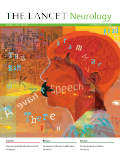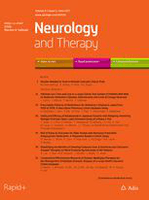
LANCET NEUROLOGY
Scope & Guideline
Leading Insights for Neurology's Future
Introduction
Aims and Scopes
- Clinical Neuroscience:
The journal publishes research that explores clinical aspects of neurological disorders, including diagnosis, treatment, and patient care strategies for conditions such as Alzheimer's disease, Parkinson's disease, and multiple sclerosis. - Neuroimaging and Biomarkers:
LANCET NEUROLOGY emphasizes the use of neuroimaging techniques and biomarkers to improve diagnosis and treatment efficacy in neurological diseases, contributing to the development of personalized medicine. - Neurodegenerative Disorders:
The journal frequently features studies on neurodegenerative diseases, focusing on their pathophysiology, genetic factors, and innovative therapeutic approaches aimed at disease modification. - Public Health and Policy:
Research addressing the public health implications of neurological disorders, including epidemiological studies and health policy discussions, is a key focus area, highlighting the global burden of neurological diseases. - Neuroimmunology:
The journal includes research on the immunological aspects of neurological diseases, particularly in autoimmune disorders like multiple sclerosis and neuromyelitis optica, exploring therapeutic interventions and immunological mechanisms. - Neurorehabilitation and Palliative Care:
Studies that investigate rehabilitation strategies for recovery from neurological injuries and palliative care approaches for chronic neurological conditions are also prominently featured.
Trending and Emerging
- Telemedicine and Remote Monitoring:
Recent papers highlight the increasing integration of telemedicine in neurology, particularly in the context of patient care during the COVID-19 pandemic, showcasing the importance of remote monitoring and consultations. - Neuroinflammation and Immune Response:
There is a growing emphasis on the role of neuroinflammation and immune mechanisms in various neurological disorders, reflecting a trend towards understanding these processes as potential therapeutic targets. - Precision Medicine and Personalized Therapies:
Research focusing on precision medicine, including genetic and biomarker-driven approaches to tailor treatments for neurological disorders, is gaining traction, indicating a shift towards more individualized patient care. - Impact of Environmental Factors on Neurological Health:
Emerging studies are increasingly addressing the influence of environmental factors, such as climate change and pollution, on neurological health, highlighting an interdisciplinary approach to understanding neurological disorders. - Digital Health Technologies:
The use of digital health tools, including apps and wearable devices for monitoring neurological conditions, is becoming a prominent theme, reflecting the integration of technology in managing neurological health.
Declining or Waning
- Historical Perspectives on Neurology:
Papers focusing on historical accounts or philosophical discussions related to neurology seem to have decreased, indicating a shift towards more empirical and clinical-focused research. - Basic Neuroscience Research:
There is a noticeable decline in basic neuroscience studies that do not have immediate clinical implications, as the journal increasingly prioritizes translational research that directly impacts patient care. - Traditional Therapeutics:
Research centered on conventional therapies without innovative approaches or insights appears to be waning, as the journal seeks to highlight cutting-edge treatments and novel therapeutic strategies. - Single-Disease Focus:
There seems to be a decline in studies that focus solely on individual diseases without considering comorbidities or broader neurological health implications, reflecting a trend towards more integrated research approaches.
Similar Journals

CANADIAN JOURNAL OF NEUROLOGICAL SCIENCES
Advancing Neurological Knowledge Since 1974Canadian Journal of Neurological Sciences, published by Cambridge University Press, stands as a reputable source of knowledge in the field of neurology, dedicated to advancing research and clinical practice. With an ISSN of 0317-1671 and an E-ISSN of 2057-0155, this journal has been a cornerstone for the exchange of ideas since its inception in 1974 and will continue to cater to the academic community until 2024. Recognized in the top quartile (Q2) in various categories including Medicine (miscellaneous) and Neurology (clinical), its articles engage a broad audience, ranging from established researchers to students seeking to deepen their understanding of neurological sciences. Although the journal is not an open-access publication, it provides vital insights and research findings that contribute significantly to its fields. With a Scopus rank of #183 in clinical neurology and a percentile ranking that reflects its commendable standing, the Canadian Journal of Neurological Sciences is indispensable for those committed to the exploration and treatment of neurological disorders.

EUROPEAN JOURNAL OF NEUROLOGY
Shaping the Landscape of Neurological Research Since 1994.EUROPEAN JOURNAL OF NEUROLOGY, published by WILEY, stands as a leading platform for the dissemination of innovative research and clinical developments in the field of neurology. With a robust impact factor and prestigious rankings, including being positioned as Q1 in both Neurology and Clinical Neurology categories, the journal plays a pivotal role in shaping neurological sciences from 1994 to 2024. Its Scopus rank highlights its importance, being in the 88th percentile for clinical neurology and 87th percentile for neuroscience. Located in the United Kingdom, the journal thrives as a vital resource for researchers, clinicians, and students dedicated to improving neurological health outcomes. Although it does not offer Open Access, its subscription-based model ensures high-quality peer-reviewed articles are accessible to a global audience, reflecting the continuous pursuit of excellence in neurological research and patient care.

NEUROLOGIC CLINICS
Elevating understanding through rigorous research.NEUROLOGIC CLINICS, published by W B SAUNDERS CO-ELSEVIER INC, stands as a leading journal in the field of clinical neurology, boasting an impressive impact factor that reflects its significant contributions to neurological research and clinical practice. With an ISSN of 0733-8619 and E-ISSN of 1557-9875, this journal provides a critical platform for the dissemination of innovative research, case studies, and reviews focusing on various aspects of neurology, from diagnosis to treatment interventions. As part of its commitment to advancing the understanding of neurological disorders, NEUROLOGIC CLINICS is categorized in the Q2 quartile for Neurology (clinical) in 2023, indicating its robust standing within the academic community. It is recognized for its rigorous peer-review process and is indexed in Scopus, ranking #147 out of 400 in its field with a notable 63rd percentile. The journal, which dates back to 1983 and continues to publish vital findings up to 2024, is an invaluable resource for researchers, healthcare professionals, and students dedicated to enhancing their knowledge and clinical skills in neurology. Subscribe now to stay abreast of current advancements and expand your expertise in this dynamic field.

Neurology and Therapy
Transforming Patient Outcomes with Cutting-Edge Neurological ResearchNeurology and Therapy, published by SPRINGER LONDON LTD, stands as a pivotal platform for researchers and practitioners in the field of neurology and its therapeutic applications. This Open Access journal, active since 2012, facilitates the dissemination of innovative studies and cutting-edge findings aimed at improving neurological health. With an impressive ranking in the 2023 Scopus Rankings, where it holds a Q2 category in Neurology and a Q1 category in Clinical Neurology, it underscores its prominence in advancing neurological research. The journal's intriguing scope encompasses a wide-ranging exploration of neurological disorders, treatment methodologies, and healthcare strategies, making it a valuable resource for those vested in enhancing patient outcomes. With an appealing average impact factor, readers are encouraged to dive into the latest advancements and engage with the scholarly discussions that are shaping the future of neurology.

NEUROLOGY
Shaping the future of neurology through rigorous research.NEUROLOGY, published by Lippincott Williams & Wilkins, stands as a premier journal in the field of neurology, holding an esteemed Q1 category ranking in clinical neurology as of 2023. Established in 1951, this journal has been a critical resource for the dissemination of cutting-edge research and clinical advancements, with an impressive Scopus rank of 24 out of 400, placing it in the 94th percentile among its peers. NEUROLOGY serves as a vital platform for neurologists, researchers, and medical professionals seeking to stay abreast of the latest findings and innovations in the treatment and understanding of neurological disorders. With its rigorous peer-review process and commitment to excellence, NEUROLOGY remains essential reading for all individuals dedicated to advancing the science and practice of neurology, contributing significantly to the ongoing dialogue in this vital area of medicine.

METABOLIC BRAIN DISEASE
Elevating research on brain health and metabolism.METABOLIC BRAIN DISEASE, published by SPRINGER/PLENUM PUBLISHERS, is a leading journal dedicated to advancing our understanding of the metabolic processes impacting brain health and disease. Established in 1986 and set to continue until 2024, this journal encompasses a wide range of interdisciplinary research that intersects the fields of Biochemistry, Cellular and Molecular Neuroscience, and Neurology, as evidenced by its notable quartile placements in Q2 and Q3 for 2023. With an ISSN of 0885-7490 and an E-ISSN of 1573-7365, it serves as a vital resource for researchers and practitioners aiming to deepen their insights into cerebral metabolic disorders and their implications. Although currently not an Open Access option, its rigorous peer-review process ensures that high-quality, impactful research reaches its audience. Showcasing a significant rank within the top percentile of its categories, METABOLIC BRAIN DISEASE is instrumental in shaping the future of neurological research and clinical applications.

Turkish Journal of Neurology
Elevating clinical practices through shared knowledge.Turkish Journal of Neurology, published by GALENOS PUBL HOUSE, is a pivotal open-access journal established in 2004, dedicated to advancing the field of neurology. Renowned for its inclusive approach, this journal serves as a vital platform for researchers and clinicians to share their findings and insights related to neurological disorders and clinical practices, with an emphasis on enhancing the understanding of various neurological conditions affecting populations in Turkey and beyond. Although it holds a Q4 rank in Neurology (Clinical) as per the 2023 category quartiles, the journal's commitment to fostering knowledge exchange remains steadfast, aiming to bridge gaps in clinical research and practice. With an ISSN of 1301-062X and an E-ISSN of 1309-2545, it is indexed in Scopus, ranking 349 out of 400, reflecting its growing presence in the academic sphere. Located in Istanbul, Turkey, the journal invites submissions from both emerging and established researchers to contribute to its diverse content, thereby enhancing its impact on the local and international neurology community.

Neurologia i Neurochirurgia Polska
Shaping the Future of Neurological CareNeurologia i Neurochirurgia Polska is a prestigious Polish journal dedicated to advancements in the fields of neurology and neurosurgery, published by VIA MEDICA. With a rich history dating back to 1967, this journal serves as a critical platform for disseminating significant research findings and clinical practices that advance our understanding of neurological disorders and surgical interventions. Registered under ISSN 0028-3843 and E-ISSN 1897-4260, it boasts commendable rankings as reflected in its 2023 categorical quartiles: Q3 in Neurology (Clinical) and Q2 in Surgery, indicating its substantial impact within these domains. Furthermore, its Scopus rankings reveal that it is positioned at Rank #125/551 within Medicine-Surgery and Rank #187/400 in Medicine-Neurology (Clinical), showcasing its importance in academic and clinical circles. Although not currently open access, the journal remains accessible to readers and practitioners who seek to stay updated on innovative research and methodologies. The journal’s objective is to foster knowledge exchange and stimulate scientific dialogue among researchers, professionals, and students, thus shaping the future of neurology and neurosurgery in Poland and beyond. Located at UL SWIETOKRZYSKA 73, 80-180 GDANSK, POLAND, it invites contributions that inspire and elevate the standards of medical practice.

ANNALS OF NEUROLOGY
Fostering Scholarly Dialogue in NeurologyANNALS OF NEUROLOGY, published by Wiley, stands as a leading journal in the field of neurology, renowned for its rigorous peer-reviewed articles that contribute significantly to the understanding of neurological disorders and advances in clinical practices. With an impressive impact factor and ranked Q1 in both neurology and clinical neurology categories, this journal positions itself among the top repositories of cutting-edge research, indexed in Scopus with exemplary ranks in the 98th and 97th percentiles respectively. Since its inception in 1977 and with a commitment to excellence extending to 2024 and beyond, ANNALS OF NEUROLOGY aims to disseminate groundbreaking studies and foster dialogue within the academic community, making it an essential resource for researchers, healthcare professionals, and students dedicated to neurology. Although it does not currently offer open access, its accessibility through institutional subscriptions facilitates widespread scholarly engagement.

NeuroImage-Clinical
Shaping the Future of Neuroscience through Collaborative ResearchNeuroImage-Clinical is a premier open access journal published by Elsevier Science Ltd, dedicated to advancing the field of clinical neuroimaging and its applications in a variety of neurological disorders. With an ISSN of 2213-1582, this journal has established itself as a leading source of innovative research since its inception in 2012, now continuing through 2024. Recognized for its high impact, it occupies the top quartile (Q1) in prestigious categories such as Cognitive Neuroscience, Neurology, and Radiology, affirming its relevance in clinical and research settings. Its Scopus rankings further exemplify its significant contribution to the disciplines of Radiology and Neurology, consistently placing it among the top tiers of journals in these fields. This journal not only provides critical insights for researchers and professionals but also serves as a valuable resource for students, fostering an understanding of the complexities in neuroimaging techniques and their implications for patient care. With open access options ensuring broad dissemination of knowledge, NeuroImage-Clinical plays a pivotal role in enhancing collaboration and innovation within the global neuroscience community.